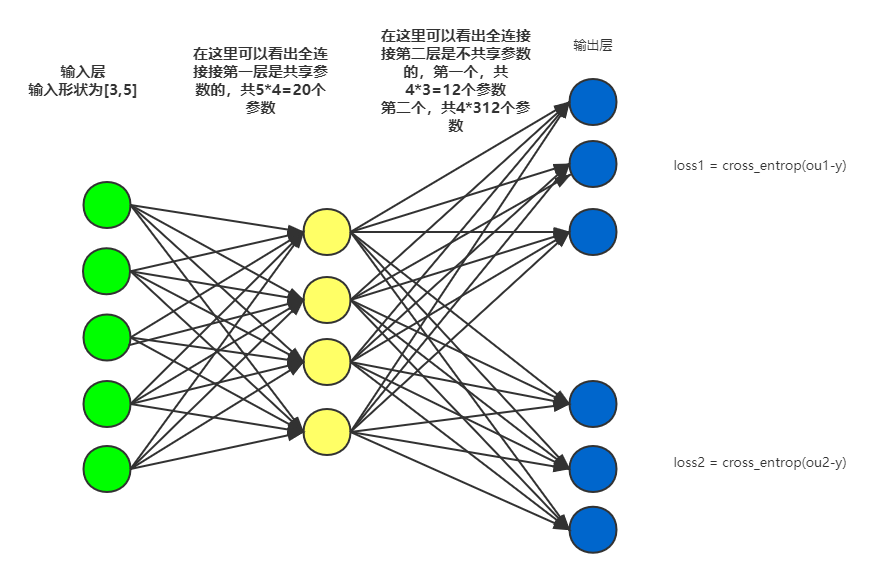- 一个输入两个输出的全连接网络
import torch
import torch.nn as nn
import torch.nn.functional as F
class LinearNet(nn.Module):
def __init__(self):
super(LinearNet, self).__init__()
self.fc1 = nn.Linear(5, 4)
self.fc2 = nn.Linear(4, 3)
self.fc3 = nn.Linear(4, 3)
def forward(self, x):
mid = self.fc1(x)
out1 = self.fc2(mid)
out2 = self.fc3(mid)
return out1, out2
x = torch.randn((3, 5))
y = torch.torch.randint(3, (3,), dtype=torch.int64)
model = LinearNet()
model.train()
optim = torch.optim.RMSprop(model.parameters(), lr=0.001)
print(model.fc2.weight)
print(model.fc3.weight)
for i in range(5):
out1, out2 = model(x)
loss1 = F.cross_entropy(out1, y)
loss2 = F.cross_entropy(out2, y)
loss = 0*loss1 + 1*loss2
optim.zero_grad()
# loss1.backward(retain_graph=True)
# loss2.backward()
# print(loss)
loss.backward()
optim.step()
print("-------------after-----------")
print(model.fc2.weight)
print(model.fc3.weight)

上述代码是一个简单的双分支输出的全连接网络,可以通过控制loss1和loss2的权重分别去控制每个输出对网络的梯度影响。如果loss1或者loss2的权重设置为0则该损失所影响的部分梯度不再更新。
2. 一个输入两个输出的卷积网络
import torch
from torch.autograd import Variable
import torch.nn as nn
import torch.nn.functional as F
class Net(nn.Module):
def __init__(self):
#使用super()方法调用基类的构造器,即nn.Module.__init__(self)
super(Net,self).__init__()
# 1 input image channel ,6 output channels,5x5 square convolution kernel
self.conv1=nn.Conv2d(1,6,5)
# 6 input channl,16 output channels,5x5 square convolution kernel
self.conv2=nn.Conv2d(6,16,5)
self.conv3 = nn.Conv2d(6, 16, 5)
# an affine operation:y=Wx+b
# self.fc1=nn.Linear(16*5*5,120)
# self.fc2=nn.Linear(120,84)
# self.fc3=nn.Linear(84,10)
def forward(self,x):
# x是网络的输入,然后将x前向传播,最后得到输出
# 下面两句定义了两个2x2的池化层
x=F.max_pool2d(F.relu(self.conv1(x)),(2,2))
# if the size is square you can only specify a single number
x1=F.max_pool2d(F.relu(self.conv2(x)),2)
x2 = F.max_pool2d(F.relu(self.conv3(x)), 2)
# x=x.view(-1,self.num_flat_features(x))
# x=F.relu(self.fc1(x))
# x=F.relu(self.fc2(x))
# x=self.fc3(x)
return x1,x2
def num_flat_features(self,x):
size=x.size()[1:] # all dimensions except the batch dimension
num_features=1
for s in size:
num_features*=s
return num_features
if __name__ == '__main__':
net=Net()
print(net)
net.train()
optim = torch.optim.RMSprop(net.parameters(), lr=0.001)
x = Variable(torch.randn(1, 1, 64, 64))
# y1,y2 = net(x)
y = Variable(torch.randn(1, 16, 13,13))
# print(y)
# print(y1.shape,y2.shape)
print(net.conv2.weight)
print(net.conv3.weight)
mseloss = torch.nn.MSELoss()
for i in range(4):
y1, y2 = net(x)
print(y1[0].shape,y.shape)
loss1 = mseloss(y1,y)
loss2 = mseloss(y2,y)
loss = 0*loss1 + 1 * loss2
optim.zero_grad()
# loss1.backward(retain_graph=True)
# loss2.backward()
# print(loss)
loss.backward()
optim.step()
print("-------------after-----------")
print(net.conv2.weight)
print(net.conv3.weight)
上述代码是一个简单的双分支输出的卷积神经网络,与全连接网络类似,该网络也可以通过控制loss1和loss2的权重分别去控制每个输出对网络的梯度影响。而且通过加权计算的loss统一进行梯度回归计算出的值和loss1和loss2分别进行梯度回归计算出的值大小是一致的。
参考链接,我是参考这个博主的资料的,感谢该博主。多损失回传机制
最后
以上就是可爱板栗最近收集整理的关于pytorch多损失回传案例的全部内容,更多相关pytorch多损失回传案例内容请搜索靠谱客的其他文章。
本图文内容来源于网友提供,作为学习参考使用,或来自网络收集整理,版权属于原作者所有。








发表评论 取消回复